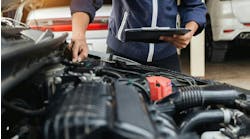How do you respond when your customers ask for this service?
Personally, I cringe. More often than not, there is an underlying problem the customer thinks will be cured by this magical procedure. After all, most dictionaries define tune-up as "a general adjustment to ensure operation at peak efficiency." Wait a minute. Isn't that the job of the engine control module (ECM)? Doesn't it monitor a variety of parameters in order to constantly make adjustments in timing and fuel mixture to ensure operation at peak efficiency? Couldn't we tell our customers that their car is constantly performing a tune-up on itself?
In simpler times, the devices that controlled timing and fuel mixture were mechanical and prone to wear and tear.
Carbureted engines periodically needed their idle mixture and speed adjusted. Sometimes, the choke operation needed tweaking or the accelerator pump needed tuning.
Not anymore, the ECM does that.
If the ECM does most of the tune-up, then why are we still selling this service to our customers?
Because there still are the concerns of normal wear and tear to address. Spark plugs wear, air filters get dirty, belts get loose. If the idea of a tune-up is to ensure operation at peak efficiency, then today's tune-up should focus on replacing those wear and tear items and helping our customers prolong the lives of their automobiles.Routine Maintenance
Besides offering tune-ups on their menu boards, some shops offer package services in order to better help their customers maintain their cars. From a simple oil change/tire rotation to more involved "30-60-90" services that include coolant and transmission fluid maintenance, these offerings allow the consumer to choose based on his or her perceived vehicle needs and his or her budget. But because these packages are generic and not make/model specific, they can offer either too much or too little.
Follow the severe conditions maintenance schedule if you drive your vehicle MAINLY under one or more of the following conditions:
- driving less than 5 miles per trip OR less than 10 miles per trip in freezing temperatures.
- driving in extremely hot (above 90 degrees F) conditions.
- extensive idling or long periods of stop-and-go driving, such as a taxi or commercial vehicle.
- trailer towing, driving with a roof rack, or driving in mountainous conditions.
- driving on muddy, dusty or de-iced roads.
I don't know about you, but I can easily meet at least one of those! Recommend using the severe schedule to your customers to help them ensure operation at peak efficiency.
System Maintenance Tips
Here's a smorgasbord of tips and information to help you help your customers keep their cars running at its best.
Filters: Do you check the filters on a customer's car every time you service it? Yes, I know some air filters aren't the easiest to get to. But while drivability issues resulting from clogged filters aren't as common as they once were, they still can happen. In addition, dirt and debris getting past the filter end up in the engine and engine oil.
Test strips, if used properly, can be used to gauge the condition of the brake fluid and provide evidence of the need for service. Recommendations for power steering, differential and transfer case fluids can be based on condition or mileage interval. Remember to tell your customers that these vital fluids protect components that are a lot more expensive to repair or replace than they are to maintain.
Don't do "drain and fills." You're not doing yourself or your customers any favors. Use the appropriate fluid service equipment to thoroughly flush and replace the fluids you are servicing.
Lubrication: Those grease fittings on the suspension components are there for a reason. While they are not as common as they used to be, many models still have them. Be sure to take the time to lube them up whenever you're performing an oil change. Check driveshaft U-joints for fittings and lube them as well. If you want to make points with your customer, take the time to lubricate the door, hood and trunk hinge points at the same time.Ignition: Worn secondary ignition components (plugs/wires) are a leading cause of ignition coil failure. I believe it is reasonable to recommend the replacement of conventional plugs every 30,000 miles and precious metal plugs every 60,000 miles to avoid the additional costs of replacing coil assemblies.
Inspect the wires and boots for wear, damage or oil contamination from leaking valve cover seals. While most spark plugs come out of the box properly gapped, you never know when the parts guy might have dropped one. Use a round wire feeler gauge to check the gap, and avoid the ramp-style gap tool the tool guy gave you for your key chain.
Fuel: If clean fuel is getting to the injectors, there should be little service needed to keep them that way. If a drivability problem exists that suggests the need for injector cleaning, sell the service based on that.
However, induction cleaning is becoming more and more of a routine service need. You've seen the coke build-up on throttle plates and may be offering their cleaning to your customers already, but there's more. In the days of carburetion, fuel was added to the airstream early in the intake manifold. Fuel is one heck of a solvent, and it kept the intake tract all the way to the combustion chamber pretty clean.
Now it's a different story. Unburned exhaust remnants full of oily goo are returned to the intake stream via the exhaust gas recirculation (EGR) system, and the positive crankcase ventilation (PCV) system can contribute some of its own when not working properly.
They typically enter the tract in about the same spot that fuel used to, and as these hot gasses hit the cooler surfaces, they begin to harden and collect. Without the fuel spray to keep the surfaces clean, they can build to the point of restricting air flow through the engine and/or cause valves to stick or intermittently seal. Many newer gasoline direct injection (GDI) designs, where the injector is located in the combustion chamber and not the intake tract, are developing severe deposits in as little as 15,000 miles.
Cleaning these deposits when heavy might require actual engine disassembly, and that is certainly a good point to share with your customers. A better solution for them is routine cleaning using any one of several good products on the market. The cleaner should be introduced early in the intake stream, and many kits include a tool that is used to inject the cleaner just upstream of the throttle body.
Underhood: The move under hood is to make everything we can electric. But there still are a lot of rubber components under the hood that need your attention. Check belt condition and the condition of the cooling system hoses. While you're under there, look for any obvious needs for repair like worn motor mounts, oil and other fluid leaks.
Speaking of electric, do yourself and your customer a favor and check the battery/starting/charging system. This test, depending on the method you prefer, takes only a few minutes and can help prevent your customer from being stranded on her way to pick up the kids from school. If the connections are corroded, clean them, and if they are severe, recommend replacement of the affected cable. It's just another way to ensure operation at peak efficiency.
Wheels/Tires: Nearly every car that enters your bay will have at least one tire that is grossly underinflated. I've actually had customers pick up their car after a service and come right back, wondering what magic I had performed to make their car feel so different. And all I did was perform my "60-second tune-up," more commonly known as correcting their tire pressures.
Tire condition and inflation directly impacts the handling and safety qualities of the car. Don't let one out of your shop that hasn't been checked for condition and inflation.
Making "general adjustments to ensure operation at peak efficiency" isn't limited to the engine, but should include all the vehicle's vital systems. The next time a customer comes in asking for a tune-up, you can give him a real education in exactly what a tune-up means.


